Syracuse, NY Pollen and Allergy Report for Summer 2023
Pollen Allergy Trends in Syracuse, NY
When is pollen lowest in Syracuse, NY?

February
Lowest month total PPM
Avg. PPM
When is pollen highest in Syracuse, NY?

April
Highest month total PPM
Avg. PPM
How does pollen in Syracuse, NY compare to New York?
Syracuse has a lower average PPM than the state of New York.
Syracuse yearly avg PPM:
New York yearly avg PPM:
How does pollen in Syracuse, NY compare to the USA?
Syracuse has a higher average PPM than the USA.
Syracuse yearly avg PPM:
USA yearly avg PPM:
Is pollen worse this year in Syracuse, NY?
Spring 2023 was worse than spring 2022.
Spring 2023 PPM:
Spring 2022 PPM:
Average PPM in Syracuse, NY
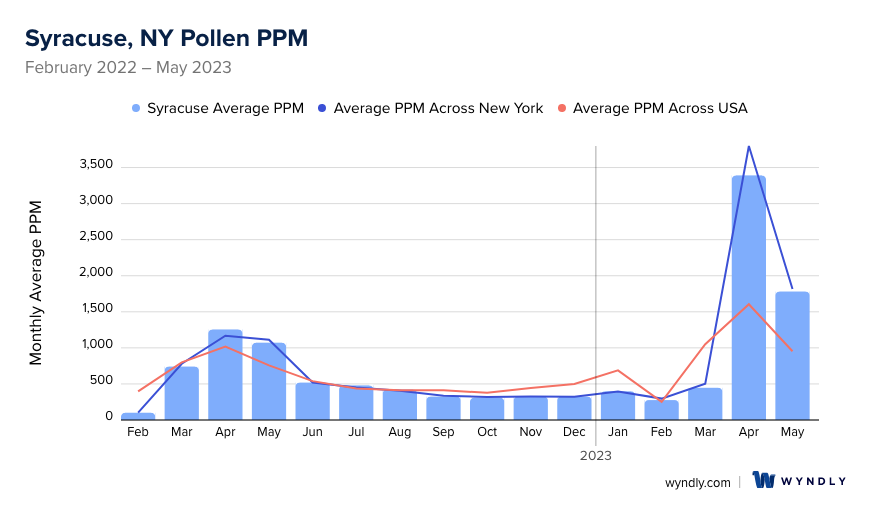
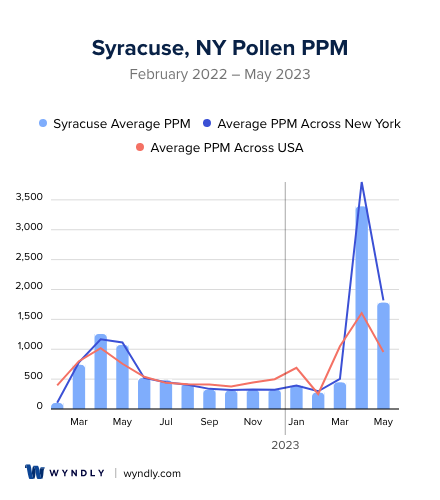
Syracuse, NY Pollen and Allergy Breakdown by Month
Grass
When is grass pollen highest in Syracuse, NY?
April has the highest grass pollen in Syracuse, NY with an average PPM of
When is grass pollen lowest in Syracuse, NY?
December has the lowest grass pollen in Syracuse, NY with an average PPM of
Tree
When is tree pollen highest in Syracuse, NY?
April has the highest tree pollen in Syracuse, NY with an average PPM of
When is tree pollen lowest in Syracuse, NY?
October has the lowest tree pollen in Syracuse, NY with an average PPM of
Weed
When is weed pollen highest in Syracuse, NY?
April has the highest weed pollen in Syracuse, NY with an average PPM of
When is weed pollen lowest in Syracuse, NY?
February has the lowest weed pollen in Syracuse, NY with an average PPM of
Syracuse, NY Pollen Monthly Breakdown by Pollen Type
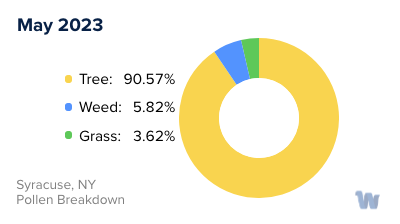
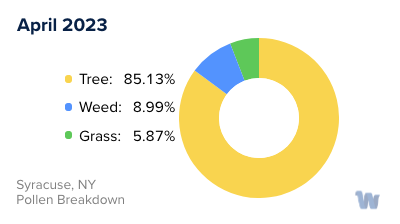
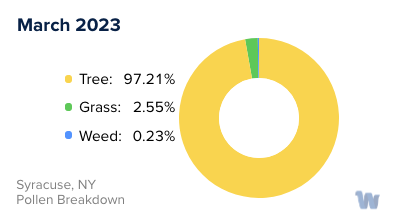
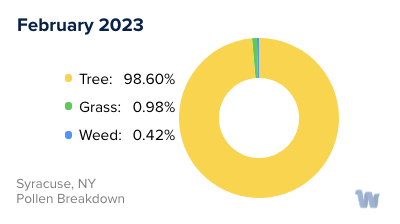
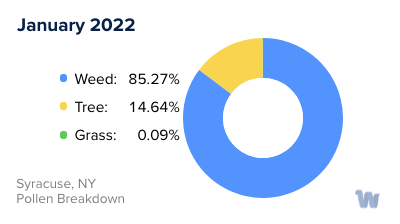
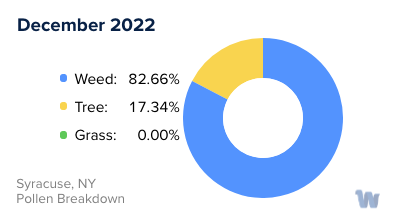
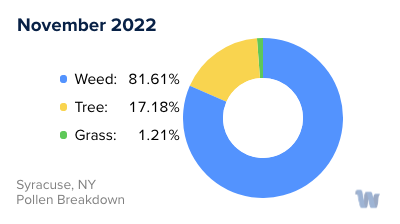
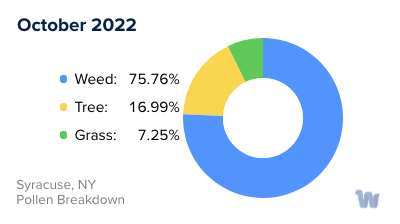
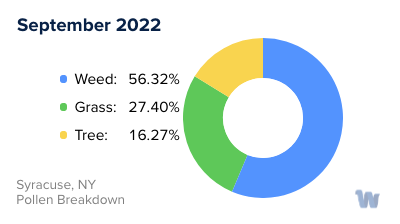
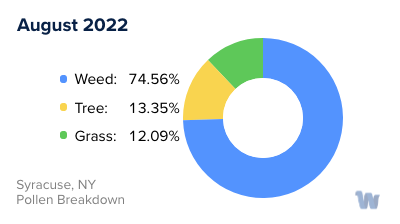
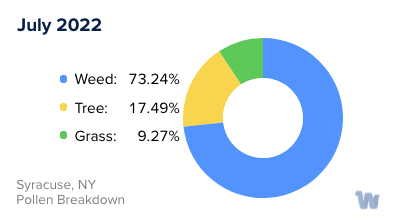
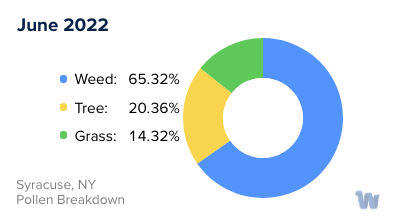
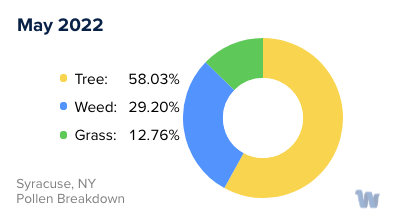
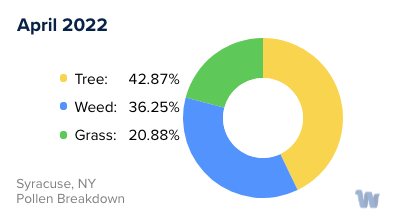
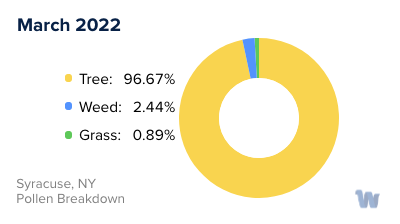
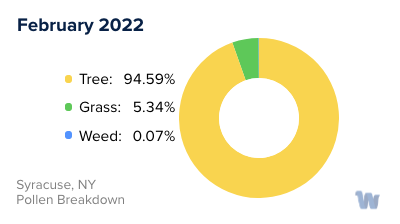
Pollen and Hay Fever in Syracuse, NY
In Syracuse, New York, pollen allergies, commonly known as hay fever, are quite prevalent. The term "hay fever" might be a bit of a misnomer because this condition doesn't have anything to do with hay or fevers. It is essentially an allergic reaction to pollen, the fine powder that plants release as part of their reproductive process.
The three primary types of pollen that cause allergies in Syracuse are tree pollen, grass pollen, and weed pollen. Tree pollen is usually the first to appear in the air, making its debut in early spring. Popular culprits in Syracuse include oak, birch, cedar, and maple trees. Their pollen can be particularly potent, causing sneezing, itchy eyes, and a runny nose.
As spring transitions into summer, grass pollen takes center stage. Grasses such as Bermuda, Kentucky bluegrass, and Timothy grass release pollen that can also contribute to the allergy symptoms experienced by many residents.
As summer winds down and we move into the fall, weed pollen becomes more prominent. Ragweed is a notorious offender in the Syracuse area. In the late summer and early fall, ragweed releases pollen that can travel for miles on the wind, affecting a large number of people.
It is important to recognize that each type of pollen has its own season. By being aware of the pollen calendar in Syracuse, individuals can better understand what may be causing their allergic reactions. Though the exact timing of pollen seasons can vary from year to year based on weather patterns, generally, tree pollen peaks in the spring, grass pollen in early to mid-summer, and weed pollen in late summer to early fall.
In summary, pollen allergies in Syracuse, New York, are influenced by tree, grass, and weed pollens. Understanding the seasonal nature of these pollens can empower residents to take proactive steps in managing their symptoms.


